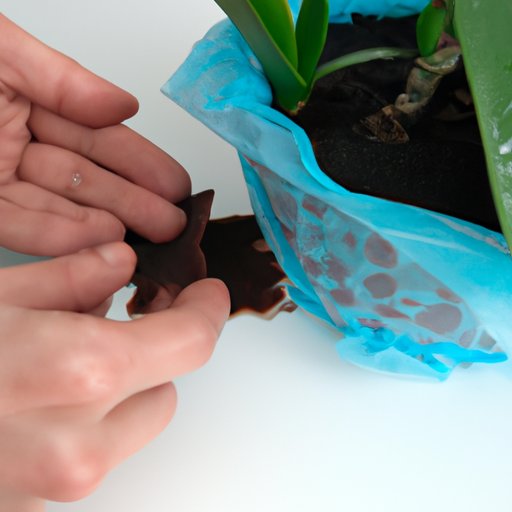
Introduction
Orchids are some of the most elegant and captivating plants, with their exotic blooms and unique shapes. But they can also be a challenge to care for, which is why we’ve put together this guide to help you keep your orchids healthy and vibrant. In this article, you’ll find a step-by-step guide to orchid care, tips for avoiding common mistakes, and answers to your most pressing questions about taking care of these beautiful plants.
Step-by-Step Guide
The key to successful orchid care is understanding what these plants need to thrive. Here are the basics:
Light:
Most orchids need bright, indirect light to grow. Too much direct sunlight can burn the leaves, while too little light can prevent them from blooming. Place your orchids near a window with filtered light or invest in a grow light if you don’t have access to natural light.
Water:
Watering an orchid can be tricky, as these plants don’t like to sit in wet soil. It’s best to water your orchid once a week in warm weather and once every two weeks in cooler weather. When watering, make sure to pour enough water that it runs through the potting mix, then allow the excess to drain away. Don’t water again until the potting mix has dried out, but don’t let it completely dry out between waterings.
Fertilizer:
Orchids need regular feeding to maintain healthy growth and blooms. Use a balanced orchid fertilizer every two weeks during the growing season and once a month during the dormant season. Follow the manufacturer’s instructions for application, and be cautious not to overuse fertilizer, as this can damage the roots.
Potting Mix:
Orchids need a potting mix that provides good drainage and aeration while retaining moisture. Most orchids prefer a combination of bark, sphagnum moss, and perlite. Be sure to choose a potting mix that’s appropriate for the type of orchid you have, and avoid potting your orchids in garden soil, which can become waterlogged and suffocate the roots.
Re-potting:
As their roots grow, orchids will need to be re-potted into larger containers. This is usually done every year or two, depending on the growth rate of your orchid. When re-potting, gently remove the orchid from its pot, loosen any tangled roots, and remove any dead or rotten roots. Then, place the orchid in a larger pot with fresh potting mix, being careful not to bury the leaves or stem too deeply.
Pruning:
Pruning can help encourage healthy growth and blooms, as well as prevent disease and insect infestations. Use clean, sharp scissors to trim away dead or yellowing leaves, and cut back any overgrown stems or roots. Be sure to sterilize your tools before and after use to prevent the spread of disease.
Common Mistakes
Despite their reputation for being difficult to care for, orchids can thrive with proper attention and care. Here are some common mistakes to avoid:
Overwatering:
Overwatering is one of the most common mistakes people make with orchids. Remember that orchids don’t like to sit in wet soil, so be cautious not to water too frequently. Check the potting mix for dryness before watering, and be sure to allow excess water to drain away.
Poor Air Circulation:
Orchids need plenty of air circulation to prevent fungal and bacterial growth. Make sure your orchids are not crowded by other plants, and use a fan if necessary to improve air flow.
Direct Sunlight:
As mentioned earlier, direct sunlight can damage an orchid’s leaves. Be sure to place your orchids in a location with filtered or indirect light.
Q&A Style
Here are some answers to common questions about orchid care:
When should I water my orchid?
Water your orchid once a week in warm weather and once every two weeks in cooler weather. Always check the potting mix for dryness before watering.
How can I tell if my orchid needs to be repotted?
If the potting mix is breaking down or the roots are growing out of the pot, it’s time to repot your orchid.
How can I identify pests on my orchid?
Look for signs of insect activity, such as holes in the leaves, sticky residue, or webbing. You can also use a magnifying glass to get a closer look at the leaves, stems, and roots.
Benefits of Orchids
Aside from their beauty, orchids have several benefits, including:
Air Purification:
Orchids are known for their ability to purify the air, removing harmful pollutants and toxins from indoor spaces.
Stress Reduction:
Studies have shown that caring for plants, including orchids, can reduce stress and improve mood.
Longevity:
With proper care, many orchids can live for decades, making them a long-lasting and rewarding investment.
Personal Experience
As someone who’s been growing orchids for years, I can attest to their beauty and the joy they bring. But I’ve also made my fair share of mistakes along the way. One of the most important lessons I’ve learned is to be patient and observant. Orchids can take time to acclimate to their environment, and it’s important to give them space to adjust. I’ve also discovered the value of investing in quality potting mix and fertilizer, as well as keeping a close eye on air circulation. With a little attention and care, anyone can enjoy the beauty of orchids in their home.
Conclusion
Orchid care can seem daunting at first, but it’s important to remember that these plants are resilient and adaptive. By following the tips and advice in this article, you’ll be well on your way to a successful and rewarding orchid-growing experience. With patience, care, and attention to detail, you can enjoy healthy, vibrant blooms for years to come.




